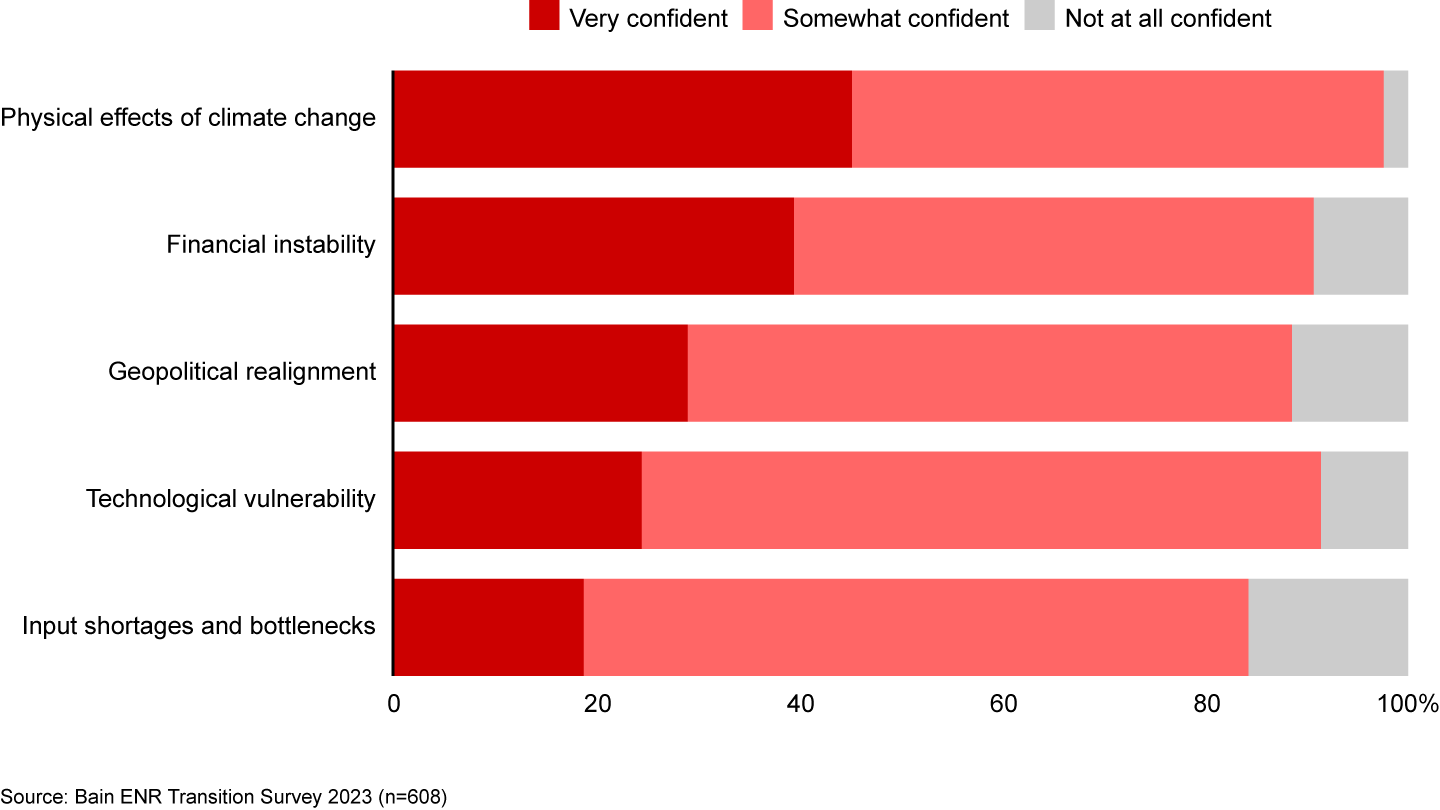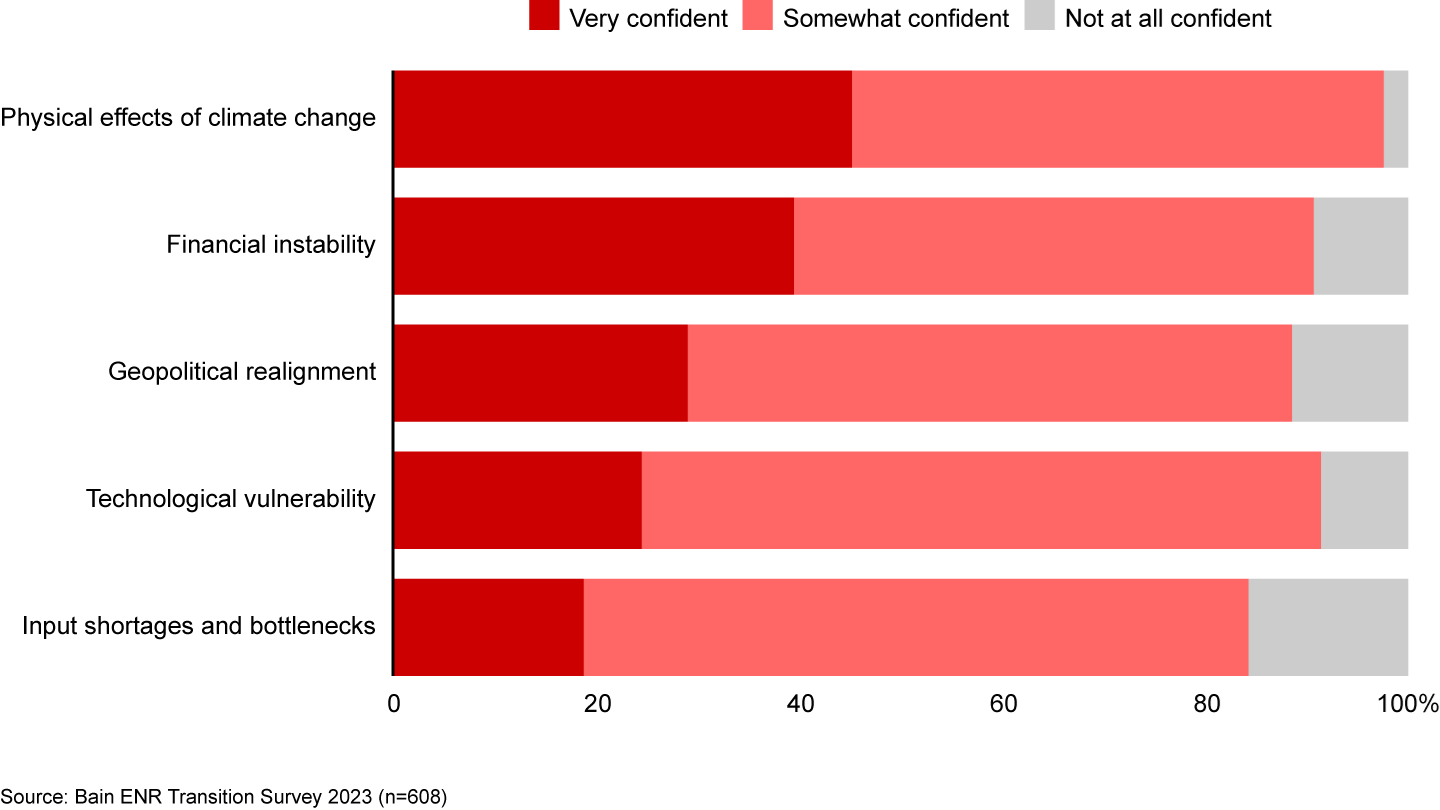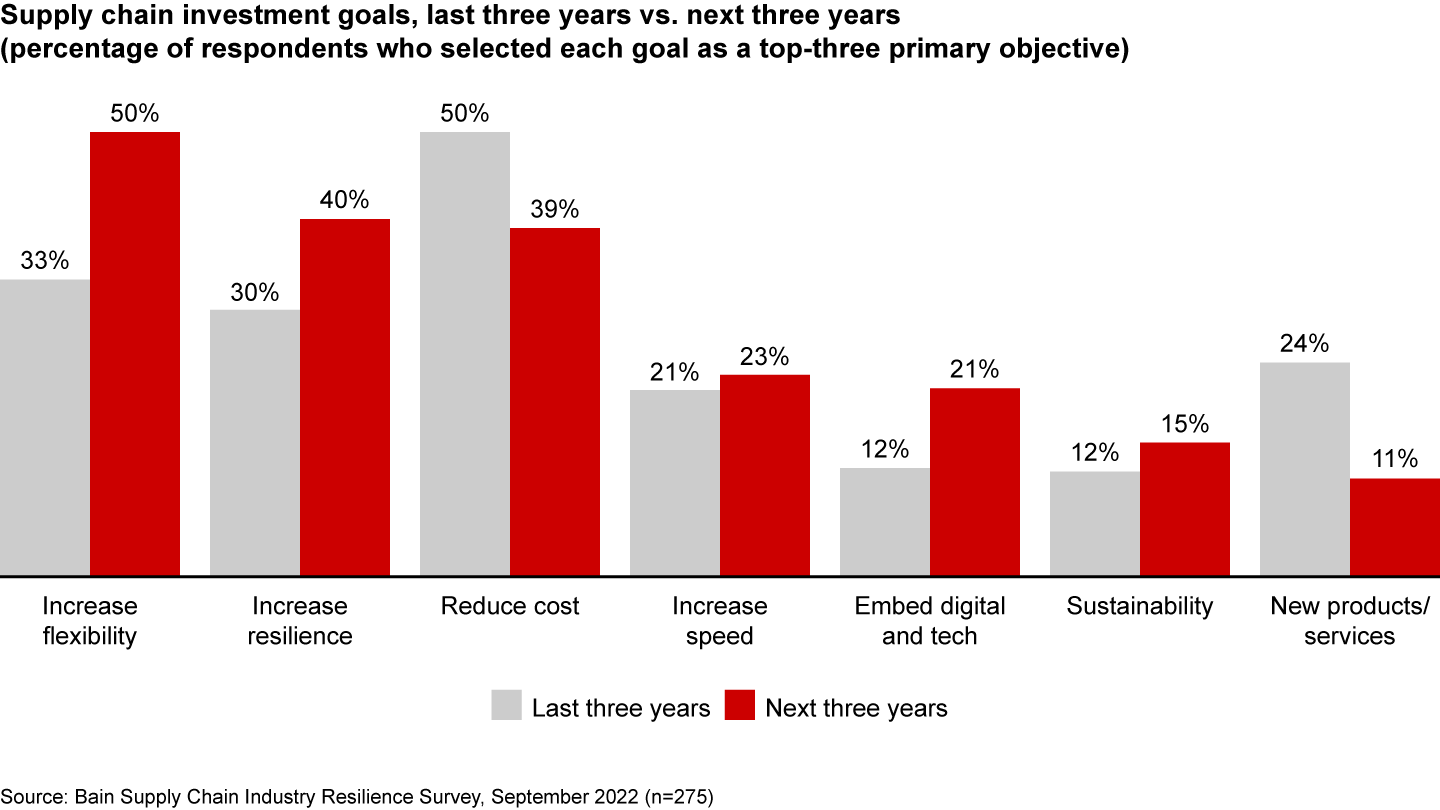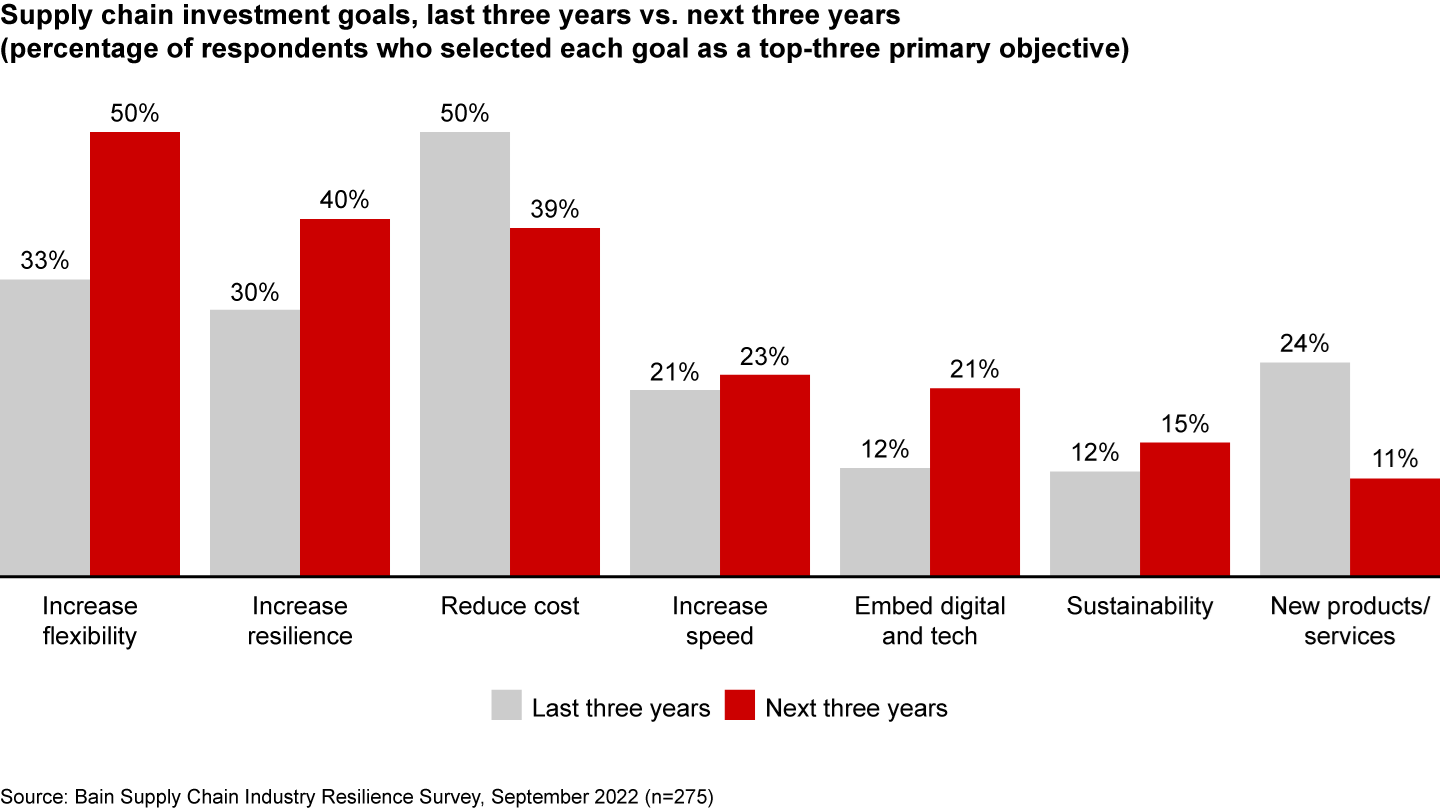The Visionary CEO’s Guide to Sustainability

At a Glance
- Traditional approaches to resilience focus on near-term risks, exposing companies to the threats of long-term challenges.
- These blind spots can leave executives overconfident about their companies’ resilience, when most have yet to be tested.
- Leaders take a broad approach that includes strategic, operational, and supply chain resilience, in addition to managing the environmental risks to physical assets.
This article is part of Bain’s 2023 CEO Sustainability Guide
We hear a lot about the need for resilience these days, but this is actually nothing new. Businesses have long faced two types of disruption. The first is unpredictable but not unprecedented major events, things like Covid-19 or the Fukushima disaster. The second is known disruptions like climate change, which play out over long periods of time and bring with them additional uncertainties, such as how the world will achieve net zero, which technologies will win and lose, and which new businesses will grow and which will decline.
Businesses must be resilient in the face of both sorts of disruption if they are to thrive amid uncertainty. Today, cultivating resilience should be top of mind for CEOs, executive teams, and boards as they lead through one of the most volatile and uncertain periods the world has seen for some time.
Resilience is likely to be one of the most critical strategic differentiators of any company’s success moving forward. But traditional corporate approaches to resilience don’t rise to today’s challenges. They focus too much on near-term risks, without fully recognizing the potential impacts up and down the value chain, well beyond individual company boundaries. They usually make very limited use of advanced predictive tools, which could help identify some of those risks. And they fail to connect risks to the organization’s long-term strategic goals and economic model.
These narrow approaches can leave blind spots and create a false sense of security. Bain recently asked executives in the energy and natural resource sector about their confidence in navigating five types of threats, spanning from the physical effects of climate change through to technological vulnerabilities, input shortages, and bottlenecks (see Figure 1). Confidence across the board appears surprisingly high, especially as many of these threats continue to escalate.
Nearly all executives said they were very or somewhat confident in their ability to manage the physical effects of climate change


These high numbers could reflect an overconfidence that’s not entirely justified by the limited investments most firms are making in resilience. People often fail to accurately assess the magnitude and likelihood of rare events, such as the physical effects of climate change, since most have not experienced them firsthand.
Leading companies take a comprehensive approach that includes strategic, operational, and supply chain resilience, in addition to managing the environmental risks to physical assets.
Strategic resilience
All strategy is formed amid some level of uncertainty, potentially handicapping a firm in several ways. Overconfidence can lead to corporate myopia; under-confidence can leave firms in paralysis. Either scenario can stall action until it’s too late to prevent a bad outcome.
"Existing assets are vulnerable to the instabilities ultimately caused by climate change and shortage of resources."
It’s rare that the losers in a transforming industry are really blindsided by change. More often, they fail to set a strategic direction that can adapt to shifting conditions. Leading firms start with a view of the future: What will customers need 30 years out? This approach can help companies set a long-term vision, free from the constraints of current practices and portfolios. Successful teams then plan for their long-term reference case, while continuously monitoring the environment and correcting course as necessary along the way.
Even among companies that invest in long-term scenario planning, few consider the “corner scenarios”—events that are possible but much less likely, like unexpected policy shocks or losing access to capital markets. Planners often shelve these scenarios because they don’t want to invest time developing detailed plans for conditions that are unlikely to occur.
But ignoring high-risk scenarios is, increasingly, a shortsighted strategy. Stress testing a company’s capabilities has never been more essential, and it’s one of the ways that planners can locate the extreme corners, in order to understand the implications and potential opportunities of low-probability, high-risk scenarios.
Operational resilience
Reducing Scope 1 and 2 emissions helps ensure long-term commercial viability in several ways. First, it positions a company to be closer to compliance as regulations or carbon taxes increase. Closely related, it helps preserve an asset’s social license to operate, making it less susceptible to being targeted as a significant carbon emitter. It can also extend the working life span of the asset, given updates that renew operational capability. Reducing emissions signals all of these benefits to investors who are considering the long-term viability of businesses, especially in rapidly changing sectors.
In addition to ensuring resilience for operations, companies also have to ensure that their decarbonization programs are resilient and can adapt to changing conditions. In this context, resilience means the ability to persevere not only through extreme weather events but also economic downturns, changes in technology, and other unpredictable barriers. Some companies are moving quickly to gain front-runner status while others are taking a wait-and-see approach, aiming to take advantage of more efficient technologies and economies of scale.
"User needs are changing, and this needs to be taken into consideration during innovation. ESG is a clear user need, so it has to be embedded in strategy while driving innovation and customer acquisition. In terms of funding, this is also becoming a must."
Supply chain resilience
Once the purview of the COO and purchasing functions, supply chain resilience has risen to the highest levels of the corporate agenda over the past few years. The pandemic, a semiconductor shortage, and war in Ukraine are among the crises that have exposed vulnerable supply chains. Quality and price are still table stakes, but increasingly supply chain executives are investing to improve flexibility and resilience (see Figure 2).
Flexibility and resilience are more becoming more important to supply chain executives


Supply chain resilience means different things in different sectors, but in general it’s the ability to proactively minimize risk, absorb inevitable shocks, and quickly recover from setbacks to lessen the impact on operations. Taking a holistic view of the entire chain can help companies identify the most important risks to the business and then assess the likelihood of each. Comparing strengths to competitors’ can help companies find opportunities to differentiate while mitigating their impacts on the environment.
Physical resilience
Many companies are already experiencing the effects of climate change on their operations. For example, in 2022, Apple and Intel suffered a weeklong shutdown of some production facilities in Sichuan, China, where a drought stalled multiple hydropower plants. But many businesses underestimate the likelihood of physical climate risk events and their exposure to them, relying on a narrow set of risk-transfer tools (for example, insurance or financial hedges) rather than a broader set of strategic and operational levers for building resilience.
"The human being only reacts when the problem is at the door and he has no other choice. The giant threat of climate change is not so tangible, because it occurs slowly, over long periods of time."
Power utility Southern California Edison, for example, has been working for more than a decade to manage the effects of climate change on its power grid and generation assets, which include more frequent wildfires and droughts that jeopardize the viability of hydroelectric power. To address these risks, SCE embarked on a detailed assessment of climate risks to its assets, operations, and services across its 50,000-square-mile service area. The results helped SCE reprioritize capital investments for new infrastructure that can withstand more intense flooding and storms, extreme temperatures, and more severe wildfires. SCE says it invests about $5 billion each year to maintain and improve its grid, and that by the end of 2021 it had reduced wildfire risk by about 70% compared with pre-2018 expectations.
A more proactive approach to resilience starts with a systemic look across the entire value chain, using analytical tools to estimate risks today and in the future. Companies can then focus on practical actions to adapt to these risks and make decisions about which assets or facilities to protect and what strategic changes may be necessary to survive and thrive. The changes may include revising capital planning processes, restructuring or nearshoring the supply chain, or advocating for new policy solutions.